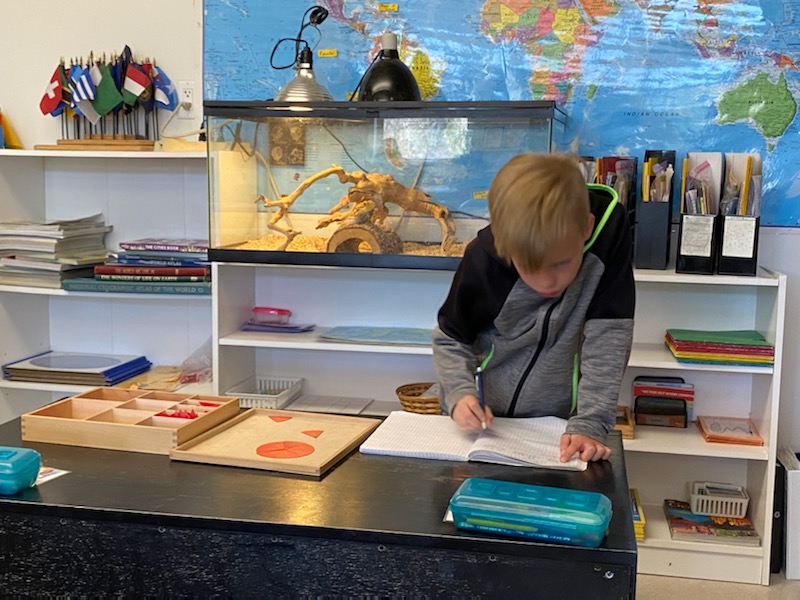4 Things to Know About Montessori Schools Today
Developed in the early 1900s the Montessori method is gaining popularity today yet continues to be misunderstood.

Montessori schools are the brainchild of Maria Montessori, an Italian physician and educator who pioneered a new approach to education in the early 1900s.
Montessori espoused the then-revolutionary concepts that children should be taught in mixed-age groups, have the ability to direct their learning, should be spared tests and formal grades, and should learn in a comfortable environment tailored to their size and needs.
Over the years, many of these ideas have made it into the educational mainstream, with practices such as mastery education, student-centered learning, and differentiated learning becoming a point of emphasis in many schools. Classroom design trends have also led to school leaders to create inviting spaces specifically for children.
The disruptions of the pandemic have made some parents more open to change, building increased interest in certain circles for Montessori schools. However, misconceptions and misunderstandings about the schools persist.
1. Montessori Schools Aren’t Only For the Wealthy
“A lot of people still see it as an educational model that, for whatever reason, is only for affluent people,” says Sara P. Suchman, executive director of the National Center for Montessori in the Public Sector.
While it's true that there are many private Montessori schools with tuition prices that may make attendance unfeasible for many children, there are also more than 550 public Montessori schools serving more than 200,000 students in the U.S. Suchman’s organization works to promote these public schools and increase access to Montessori education.
“We are here to say loud and strong that you don't need to be affluent for a Montessori classroom to offer an amazing education for your child and for your family,” Suchman says. “There are public schools that people aren't aware of and they're growing. And our work is to keep them growing so that there's more accessibility for more kids and families.”
Tools and ideas to transform education. Sign up below.
Research shows that a Montessori education helps to level the field for all kids, she adds.
2. Montessori Schools Don’t Give Students Total Control
Montessori schools emphasize student choice but it’s not taken to the level many people assume, says Sonya Hemmen, head of school at Ross Montessori School in Colorado.
“We believe that parents and most of the general population still believe that Montessori means children get to choose everything they do. This misnomer is unfortunate for Montessori,” she says.
Instead of complete free reign for children, Montessori schools provide “freedom within boundaries.” This means setting clear expectations and ground rules. “An example of how we provide this to children at Ross is the work plan,” Hemmen says. “Giving the young learners a framework for which Montessori work subjects are made available to them to guide their day is this concept in action. When prepared adults help guide children in this way, they become part of the child's daily reflection on their own productivity and discuss with them how their productivity is developing.”
3. Montessori Schools Do Utilize Technology But Differently
In Montessori schools, 3- to 6-year-olds don’t use technology but older students will use it in a manner modeled on how adults might utilize it – as a tool rather than as a replacement or even a supplement to a teacher. “You won't be doing a software program to learn how to read,” Suchman says. “But you may be doing research online. You may be using PowerPoint or creating graphs in order to communicate your learning.”
She adds, “Montessori is also about adapting to real life and learning real-life skills and technology is a real-life skill.”
In other schools, computer programs are often used to help teachers provide students with individualized learning experiences because, without those tech tools, the teacher wouldn’t have time to provide individualized instruction. “In Montessori, the materials serve the same purpose as how teachers are using screens in other classrooms,” Suchman says. “The Montessori materials encourage kids to work independently for a longer period of time, which allows the teacher to then be working with other students individually.”
4. Montessori Schools Have Evolved During the Pandemic
Some Montessori schools pushed to stay in-person because of the hands-on nature of the learning that takes place. Those who went remote had some advantages because teachers were already familiar with offering differentiated learning that met students where they were in each subject.
Whether offering in-person, online, or hybrid learning opportunities, Montessori schools, like all schools, have evolved with the times.
“We've had to get creative with schedules to accommodate germ cohorts and minimize the number of adults who mingle with each classroom,” says Erin Beaudette, director of student services at Ross Montessori School. “Throughout this process, we have been able to identify some concerns with enrichment programming, and our intervention team has become so much stronger. Each interventionist has a more diverse skill set than they did two years ago, and the children in need are being served more effectively.”
They’ve also had to respond to mental health challenges.
“The social-emotional needs of our students and families are greater than before,” Beaudette says. “Out of necessity, we have made connections and gone to training, and stepped out to support students and families in new ways. Sadly, we do not believe the social-emotional needs are going to slow down anytime soon. Thankfully, I feel we are more equipped to handle this growing need.”
Erik Ofgang is a Tech & Learning contributor. A journalist, author and educator, his work has appeared in The New York Times, the Washington Post, the Smithsonian, The Atlantic, and Associated Press. He currently teaches at Western Connecticut State University’s MFA program. While a staff writer at Connecticut Magazine he won a Society of Professional Journalism Award for his education reporting. He is interested in how humans learn and how technology can make that more effective.

